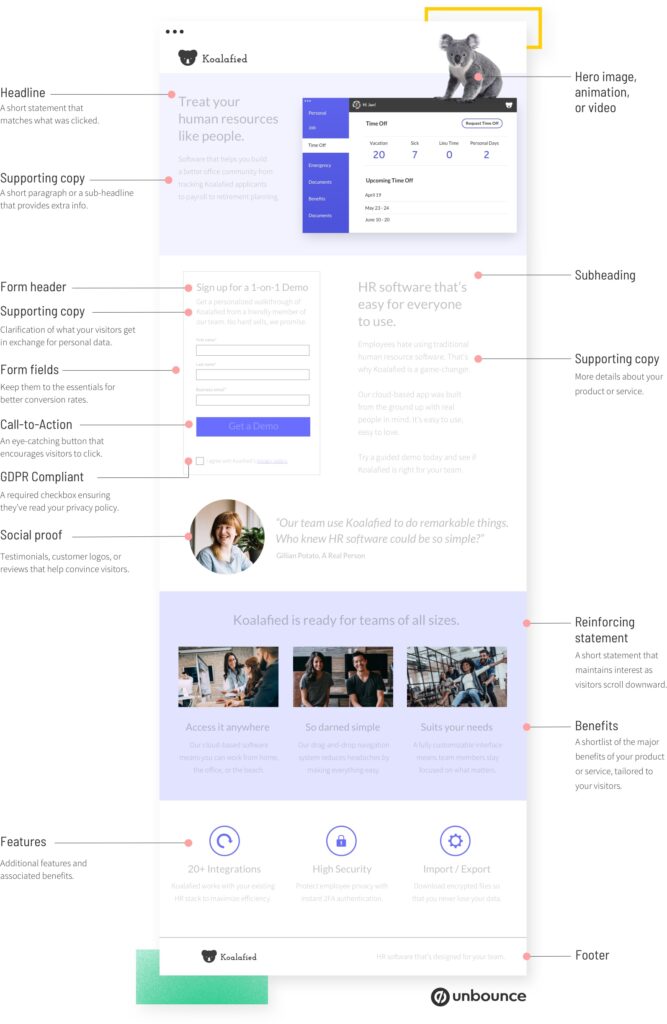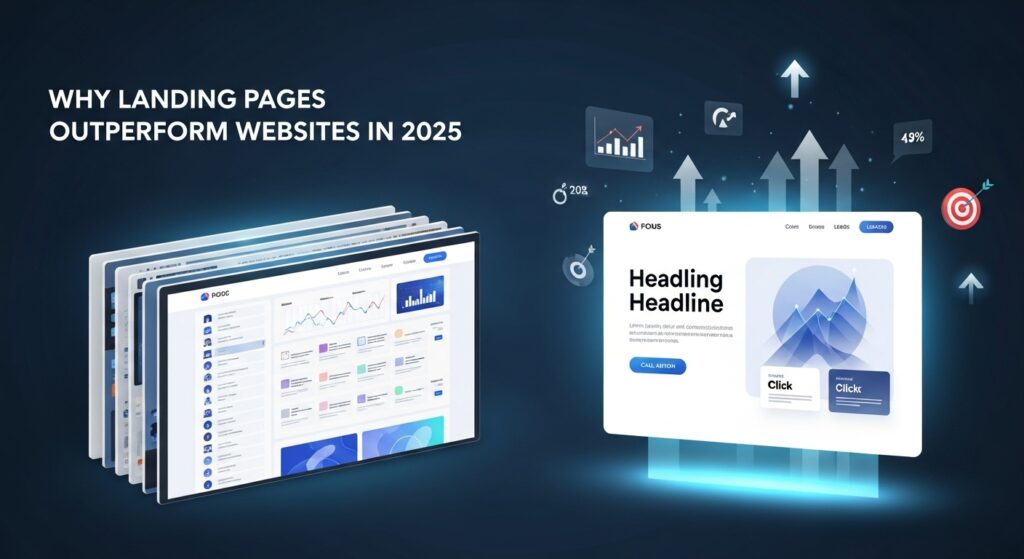In today’s fast-changing digital marketing world, speed, clarity, and conversions matter more than ever. While traditional websites are still important for branding, landing pages have become the secret weapon for businesses aiming to convert visitors into customers quickly.
By 2025, marketers across industries are focusing more on high-performing landing pages instead of relying solely on full websites. If your goal is to boost sales, grow leads, or run effective ad campaigns — landing pages are your best friend.
This educational article will help you understand what landing pages are, why they outperform websites, and how to create one that converts like magic.
🧠 1. What Is a Landing Page?
A landing page is a single, focused webpage created to achieve a specific marketing goal — like collecting leads, selling a product, promoting an offer, or encouraging users to sign up.
Unlike a regular website with multiple pages, menus, and distractions, a landing page guides users toward one clear action — known as a Call-to-Action (CTA).
👉 Examples of landing page goals:
- Get users to sign up for a newsletter.
- Sell a single product or service.
- Book a consultation or demo.
- Download an eBook or course.
- Register for an event or webinar.
A well-designed landing page removes confusion and gives users one clear path to follow — making it more effective than a traditional website homepage.
🏆 2. Landing Pages vs. Websites: What’s the Difference?
| Feature | Website 🏠 | Landing Page 🚀 |
| Structure | Multiple pages and menus | Single page with one goal |
| Navigation | Many options | No distractions, one CTA |
| Goal | Inform, educate, showcase | Convert visitors to leads or sales |
| Speed | Can be slower | Lightweight and fast |
| Focus | Broad brand messaging | Specific offer or action |
| Tracking & Testing | More complex | Easy to A/B test and optimize |
👉 In 2025, when users scroll quickly and attention spans are shorter than ever, a simple, focused landing page wins over a cluttered website.
📈 3. Why Landing Pages Outperform Websites in 2025
✅ 1. Faster Load Times = Better Conversions
Landing pages are usually lightweight and optimized for performance. A fast-loading page keeps visitors engaged.
📊 Studies show every 1-second delay can reduce conversions by 7%.
Since landing pages are minimal, they load in under 2 seconds on average — which makes them perfect for mobile users.
✅ 2. Single Focus = Higher Conversion Rates
A website homepage may offer 5–10 options, but a landing page has one action — sign up, buy now, or download.
This laser-sharp focus eliminates confusion and improves conversion rates significantly. Users don’t get distracted by multiple links or menus.
✅ 3. Perfect Match for Paid Ads
If you run Google Ads, Meta Ads, or any kind of paid campaign, sending users to a generic homepage is a big mistake.
Landing pages help:
- Match the message of the ad with the offer on the page.
- Improve Quality Score in Google Ads.
- Lower your Cost Per Click (CPC).
- Increase your Return on Ad Spend (ROAS).
👉 A visitor who clicks an ad for “Free Digital Marketing Course” expects to land on a page about that course only, not your entire website.
✅ 4. Easier to Track, Test & Optimize
Websites can be complicated to analyze. But a landing page has just one goal — making tracking and A/B testing simple.
You can easily test:
- Headline variations ✍️
- Button colors 🟢🔵
- CTA text like “Sign Up” vs. “Start Free Trial”
- Form placements 📋
This data-driven approach means you can continuously improve performance over time.
✅ 5. Higher Mobile Engagement
In 2025, over 80% of users browse on mobile devices. Landing pages are mobile-friendly by design, offering faster experiences and clear CTAs.
Websites with complex navigation often frustrate mobile users. Landing pages keep it short, simple, and action-oriented.
✅ 6. Better Storytelling with Focused Messaging
A landing page tells a single story from start to finish. You can:
- Hook the user with a strong headline.
- Build trust with benefits and social proof.
- Seal the deal with a powerful CTA.
This structured journey makes landing pages emotionally and logically persuasive.
✅ 7. Cost-Effective and Easy to Build
Unlike a large website, landing pages can be built quickly using tools like Elementor, Unbounce, or WordPress.
👉 This makes them perfect for startups, freelancers, agencies, and small businesses.
👉 You can create multiple landing pages for different campaigns without spending big on web development.
🧭 4. Elements of a High-Converting Landing Page


5
If you want your landing page to beat a traditional website, it needs to be strategically designed. Here’s what matters most:
- 🔥 Compelling Headline: Grab attention in the first 3 seconds.
- 📸 Eye-Catching Hero Image or Video: Visual storytelling boosts trust.
- ✍️ Benefit-Driven Copy: Focus on what’s in it for the user.
- ✅ Strong Call-to-Action (CTA): Make it clear and urgent.
- 📋 Simple Lead Form: Fewer fields = more conversions.
- 🧾 Social Proof: Testimonials, ratings, trust badges.
- ⚡ Fast & Mobile-Optimized: Smooth experience across devices.
- 🔐 Clear Privacy & Trust Signals: Builds credibility.
🧠 5. How to Create a Landing Page (Step-by-Step)
- Define Your Goal: Decide the single action you want users to take.
- Know Your Audience: Speak their language and address their pain points.
- Craft a Clear Headline: Summarize your offer in 1 sentence.
- Write Benefit-Focused Copy: Show value, not just features.
- Design a Strong CTA: “Get Started,” “Sign Up Now,” “Book a Demo.”
- Add Visuals & Trust Elements: Logos, reviews, badges.
- Test and Optimize: Use A/B testing to improve performance.
👉 Pro Tip: Keep your page under 5 scrolls for the best engagement.
💼 6. Real-World Use Cases of Landing Pages
- E-commerce: Promote flash sales or product launches.
- Education: Get sign-ups for online courses or webinars.
- Agencies: Book free consultations or discovery calls.
- Startups: Offer early access to a new product.
- Events: Simplify event registration and ticket sales.
Many brands in 2025 build multiple landing pages for different campaigns instead of driving all traffic to their homepage.
🧪 7. Landing Pages + AI = Smarter Marketing
Thanks to AI tools, creating and optimizing landing pages has become faster and smarter.
✅ AI can write persuasive headlines.
✅ Personalize landing page content for different audiences.
✅ Predict conversion rates and suggest improvements.
Platforms like Unbounce, HubSpot, and Instapage now include AI optimization to help marketers get better results.
⚡ 8. Common Landing Page Mistakes to Avoid
🚫 Too many CTAs or links — one page = one goal.
🚫 Slow loading speed — kills conversions.
🚫 Overloading with information — keep it clear and simple.
🚫 Forgetting mobile optimization.
🚫 Not testing and improving regularly.
Fixing these common mistakes can double or triple your conversion rates.
📊 9. The Future of Landing Pages in 2025
- Personalization: Dynamic landing pages that adapt to user behavior.
- Voice Search Optimization: Voice-activated CTAs.
- AI-driven Optimization: Auto-testing of elements.
- Interactive Elements: Quizzes, polls, and chatbots.
- Short-form Video Integration: Replacing static hero images.
Landing pages are evolving — and they’re becoming more powerful than ever.
🏁 Conclusion: Landing Pages Win the Conversion Race
In 2025, businesses can’t rely on just websites to convert leads. Landing pages give marketers the speed, focus, and performance needed to win attention in a crowded online space.
✅ Faster, cleaner, and more focused than websites.
✅ Higher conversion rates.
✅ Easier to track and optimize.
✅ Cost-effective and scalable for campaigns.
If you’re serious about growing your online business, landing pages are your best investment this year.
❓ FAQs on Landing Pages vs. Websites
Q1. Can landing pages replace websites completely?
👉 No. Websites are great for brand presence. Landing pages are ideal for focused campaigns and conversions.
Q2. Do I need coding skills to build a landing page?
👉 No. Tools like Elementor, Unbounce, and Instapage make it easy without coding.
Q3. How many landing pages should a business have?
👉 You can create a landing page for each campaign or offer. Many companies have 10+ active landing pages.
Q4. Can landing pages help with SEO?
👉 Yes, if optimized well. But they work best with paid campaigns or targeted traffic sources.
Q5. What’s a good landing page conversion rate?
👉 The average is 2–5%, but great landing pages can convert 15% or more.
🎯 Final Tip: Don’t just build landing pages — build landing pages that convert.
👉 Start with a clear goal.
👉 Keep it simple and fast.
👉 Test and improve regularly.

